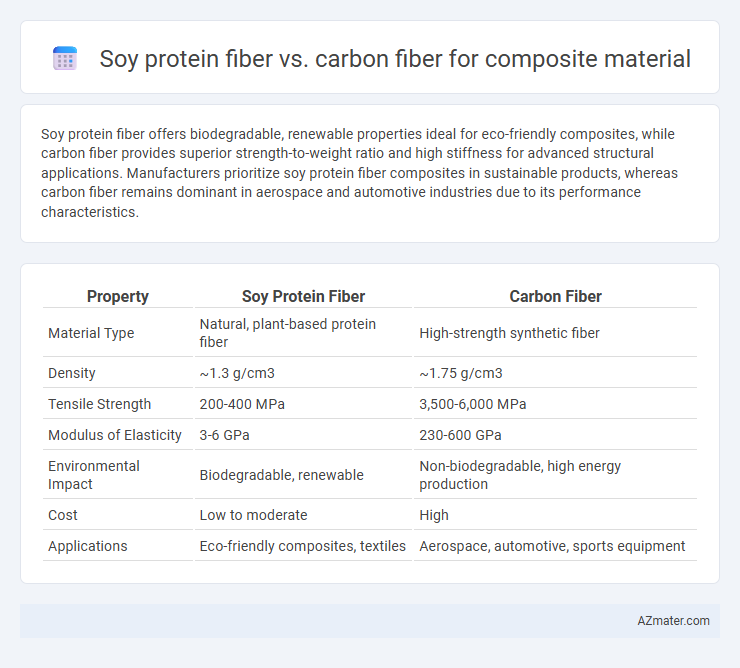Soy protein fiber offers biodegradable, renewable properties ideal for eco-friendly composites, while carbon fiber provides superior strength-to-weight ratio and high stiffness for advanced structural applications. Manufacturers prioritize soy protein fiber composites in sustainable products, whereas carbon fiber remains dominant in aerospace and automotive industries due to its performance characteristics.
Table of Comparison
| Property | Soy Protein Fiber | Carbon Fiber |
|---|---|---|
| Material Type | Natural, plant-based protein fiber | High-strength synthetic fiber |
| Density | ~1.3 g/cm3 | ~1.75 g/cm3 |
| Tensile Strength | 200-400 MPa | 3,500-6,000 MPa |
| Modulus of Elasticity | 3-6 GPa | 230-600 GPa |
| Environmental Impact | Biodegradable, renewable | Non-biodegradable, high energy production |
| Cost | Low to moderate | High |
| Applications | Eco-friendly composites, textiles | Aerospace, automotive, sports equipment |
Introduction to Composite Materials
Composite materials combine two or more distinct substances to achieve superior mechanical properties not present in individual components. Soy protein fiber, derived from renewable plant sources, offers biodegradability and lightweight characteristics but has lower tensile strength and durability compared to carbon fiber. Carbon fiber composites provide exceptional strength-to-weight ratio, stiffness, and chemical resistance, making them ideal for high-performance applications such as aerospace, automotive, and sporting goods.
Overview of Soy Protein Fiber
Soy protein fiber offers a biodegradable and sustainable alternative to synthetic fibers in composite materials, featuring low density and good mechanical properties such as tensile strength and flexibility. Its natural origin contributes to reduced environmental impact through decreased carbon footprint and enhanced recyclability compared to carbon fiber. While carbon fiber excels in high-performance applications due to superior stiffness and strength, soy protein fiber composites provide eco-friendly solutions suitable for lightweight and less demanding structural uses.
Understanding Carbon Fiber
Carbon fiber is a high-strength, lightweight material composed mainly of carbon atoms bonded in a crystal structure, offering superior tensile strength and stiffness compared to soy protein fiber. It provides exceptional mechanical properties, chemical resistance, and thermal stability, making it ideal for aerospace, automotive, and sporting goods applications. Unlike soy protein fiber, which is biodegradable and renewable but weaker, carbon fiber's durability and performance justify its higher cost in advanced composite materials.
Mechanical Properties Comparison
Soy protein fiber composites exhibit moderate tensile strength and flexibility, making them suitable for lightweight, biodegradable applications, whereas carbon fiber composites boast superior tensile strength, stiffness, and excellent fatigue resistance ideal for high-performance structural components. The elastic modulus of carbon fiber composites typically ranges between 230-600 GPa, significantly outperforming soy protein fiber composites, which generally have an elastic modulus below 10 GPa. Impact resistance and durability metrics further favor carbon fiber, reinforcing its dominance in aerospace and automotive sectors, while soy protein fibers offer eco-friendly benefits in less demanding mechanical applications.
Environmental Impact and Sustainability
Soy protein fiber offers a renewable and biodegradable alternative to carbon fiber, reducing reliance on fossil fuels and lowering carbon emissions during production. While carbon fiber provides superior strength and durability, its manufacturing process is energy-intensive and generates non-recyclable waste, posing significant environmental challenges. Integrating soy protein fiber in composite materials promotes circular economy principles, enhances sustainability, and decreases the overall ecological footprint compared to traditional carbon fiber composites.
Manufacturing Processes and Costs
Soy protein fiber composites benefit from renewable, biodegradable soy-based fibers that enable eco-friendly production with lower energy requirements and simpler manufacturing techniques such as compression molding or injection molding. Carbon fiber composites involve high-performance carbon filaments requiring energy-intensive processes like filament winding, aerospace-grade autoclave curing, or prepreg layup, resulting in significantly higher manufacturing costs. The overall cost-efficiency of soy protein fiber composites makes them attractive for automotive and consumer goods, while carbon fiber's superior strength and stiffness justify its expense in aerospace and high-performance sporting goods.
Performance in Structural Applications
Soy protein fiber composites exhibit moderate tensile strength and improved biodegradability, making them suitable for lightweight, eco-friendly structural applications with lower load requirements. Carbon fiber composites deliver exceptional stiffness, high tensile strength exceeding 3,500 MPa, and superior durability under dynamic stresses, ideal for high-performance aerospace and automotive structures. The performance gap favors carbon fiber for critical load-bearing roles, while soy protein fibers offer sustainable alternatives in applications prioritizing environmental impact over maximum strength.
Weight and Flexibility Analysis
Soy protein fiber offers a lightweight alternative to traditional carbon fiber in composite materials, with densities typically around 1.3 g/cm3 compared to carbon fiber's 1.75 g/cm3, making it advantageous for weight-sensitive applications. In terms of flexibility, soy protein fibers demonstrate higher elongation at break, ranging between 10-15%, whereas carbon fiber exhibits a much lower elongation around 1-2%, indicating superior flexibility for soy fiber composites. These properties position soy protein fiber as a promising sustainable option where reduced weight and enhanced flexibility are critical.
Future Prospects and Innovations
Soy protein fiber offers a renewable and biodegradable alternative to traditional carbon fiber in composite materials, promising significant environmental benefits. Advances in bioengineering have enhanced the strength-to-weight ratio of soy protein fibers, making them increasingly competitive for automotive and aerospace applications. Ongoing innovations in hybrid composites integrating soy protein with synthetic fibers aim to optimize performance while reducing the carbon footprint of manufacturing processes.
Conclusion: Choosing the Right Fiber for Composites
Soy protein fiber offers a sustainable and biodegradable option with good mechanical properties suitable for lightweight, eco-friendly composite applications. Carbon fiber outperforms in strength, stiffness, and durability, making it ideal for high-performance and structural composites despite higher costs and environmental impact. Selecting the right fiber depends on balancing performance requirements, environmental considerations, and budget constraints specific to the composite's end-use.

Infographic: Soy protein fiber vs Carbon fiber for Composite Material
 azmater.com
azmater.com